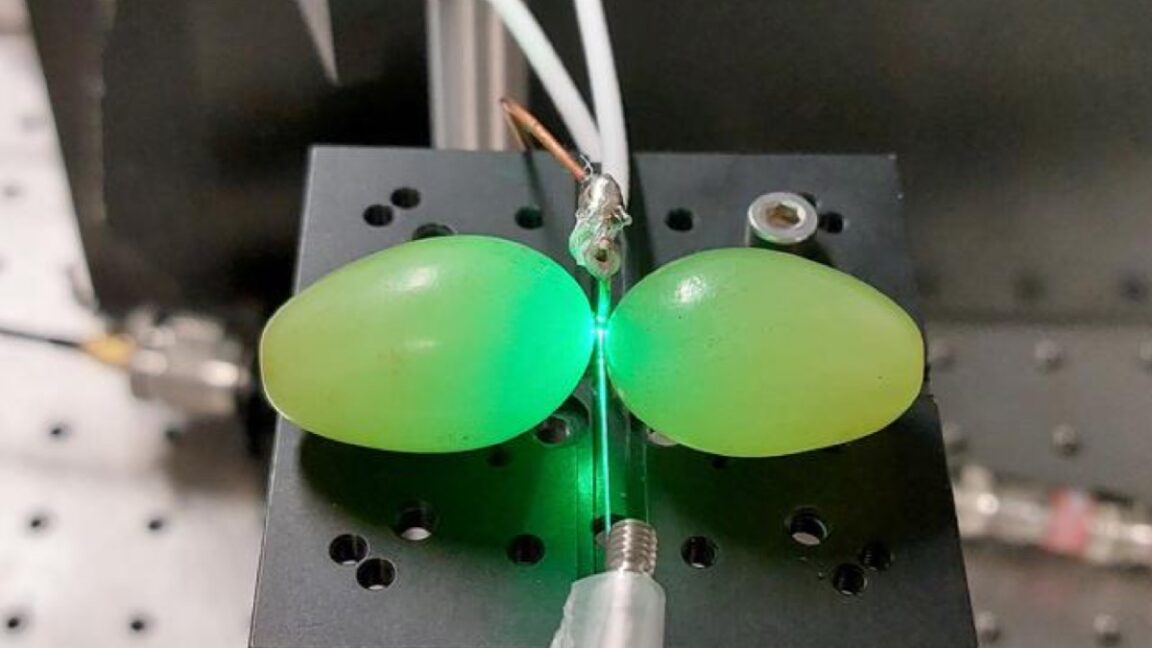Could microwaved grapes be used for quantum sensing?
the wrath of grapes Could microwaved grapes be used for quantum sensing? Halved grapes boost magnetic fields, paving way for alternative microwave resonators for quantum sensing devices. Jennifer Ouellette Dec 27, 2024 10:46 am | 7 Grapes show promise for quantum sensing breakthrough Credit: Fawaz, Nair, Volz Grapes show promise for quantum sensing breakthrough Credit: Fawaz, Nair, Volz Story textSizeSmallStandardLargeWidth *StandardWideLinksStandardOrange* Subscribers only Learn moreThere are thousands of YouTube videos in which DIY science enthusiasts cut grapes in halfleaving just a thin bit of skin connecting themand put the grapes in the microwave, just to marvel at the sparks and plume of ionized gas (plasma) that the grapes produce. This quirky property of grapes might help make more efficient quantum sensors, according to a new paper published in the journal Physical Review Applied.The plasma-inducing grape effect was first observed in 1994, per the authors. As previously reported, the usual explanation for the generation of plasmas is that grapes are so small that the irradiating microwaves become highly concentrated in the grape tissue, ripping some the molecules apart to generate charged ions (adding to the electrolytes already present in the grapes). The electromagnetic field that forms causes ions to flow from one grape half to the other via the connecting skinat least at first. That's when you get the initial sparks. Eventually, the ions start passing through the surrounding air as well, ionizing it to produce that hot plume of plasma.But in 2019, Trent University scientists showed that explanation isn't quite right. The skin bridge isn't necessary for the effect to occur. Rather, the plasma is generated by an electromagnetic "hot spot." The grapes have the right refractive index and size to "trap" microwaves, so putting two of them close together leads to the generation of a hot spot between them. The trick also works with gooseberries, large blackberries, and quail eggs, as well as hydrogel beadsplastic beads soaked in water. ("Many microwaves were in fact harmed during the experiments," co-author Hamza Khattak admitted at the time.)The microwaved grape trick also shows their promise as alternative microwave resonators for quantum sensing applications, according to the authors of this latest paper. Those applications include satellite technology, masers, microwave photon detection, hunting for axions (a dark matter candidate), and various quantum systems, and driving spin in superconducting qubits for quantum computing, among others.Prior research had specifically investigated the electrical fields behind the plasma effect. "We showed that grape pairs can also enhance magnetic fields which are crucial for quantum sensing applications," said co-author Ali Fawaz, a graduate student at Macquarie University.Fawaz and co-authors used specially fabricated nanodiamonds for their experiments. Unlike pure diamonds, which are colorless, some of the carbon atoms in the nanodiamonds were replaced, creating tiny defect centers that act like tiny magnets, making them ideal for quantum sensing. Sapphires are typically used for this purpose, but Fawaz et al. realized that water conducts microwave energy better than sapphiresand grapes are mostly water.So the team placed a nanodiamond atop a thin glass fiber and placed it between two grapes. Then they shone green laser light through the fiber, making the defect centers glow red. Measuring the brightness told them the strength of the magnetic field around the grapes, which turned out to be twice as strong with grapes than without.The size and shape of the grapes used in the experiments proved crucial; they must be about 27 millimeters long to get concentrated microwave energy at just the right frequency for the quantum sensor. The biggest catch is that using the grapes proved to be less stable with more energy loss. Future research may identify more reliable potential materials to achieve a similar effect.DOI: Physical Review Applied, 2024. 10.1103/PhysRevApplied.22.064078 (About DOIs).Jennifer OuelletteSenior WriterJennifer OuelletteSenior Writer Jennifer is a senior reporter at Ars Technica with a particular focus on where science meets culture, covering everything from physics and related interdisciplinary topics to her favorite films and TV series. Jennifer lives in Baltimore with her spouse, physicist Sean M. Carroll, and their two cats, Ariel and Caliban. 7 Comments


